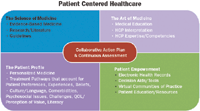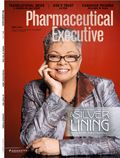Bridging the HCP-Patient Gap
Pfizer's Sarah Krug describes what's necessary to bridge the gap between the patient revolution and healthcare provider in the 21st century
Little does one realize that a harmonious relationship must exist between a philharmonic's conductor and his orchestra to ensure a flawless performance. The conductor determines tempo, encourages precise composition of notes, and listens critically to contour the sound of the ensemble, which unifies the orchestra. The craft of conducting requires the ability to inspire, stimulate, and challenge the performers. A symphonic experience is also highly dependent on the skill set of the performers, and only those capable of delivering musical expressions in synch with the conductor's guidance will be successful. It is this type of symbiotic relationship that we in the healthcare setting can learn from and apply to the healthcare provider (HCP)/patient relationship.
The Catalyst to Change
Patients are an all-too-often invisible stakeholder in the healthcare system. The traditional provider-centric healthcare model focuses on the medical disease, with the HCP viewed as the 'knowing' expert and the patient a 'passive' recipient. However, the roles have shifted, and patients are taking a more active stance in their disease management. In this case, both patients and HCPs are experts: Patients are experts on their lives and experiences, and HCPs are experts on the art and science of medicine. Catalyzed by new technology, a patient revolution is under way: Patients are seeking and sharing more healthcare information online and are increasingly showing a desire to be equal partners in the participatory medicine movement.
Patient empowerment is the missing catalyst in affecting change and is based on basic principles of engagement, knowledge, skills, and attitudes, which affect behavior changes that can improve treatment concordance, adverse event management, and mitigate medical errors. A patient is empowered when provided with sufficient knowledge to make informed decisions, given adequate control and resources to implement their choices, and is armed with the necessary experiences to evaluate the effectiveness and impact of the steps taken. Essentially, patients may be architects of their own success, but this requires that they be recognized as a partner in the circle of care.
The Conundrum
Despite its theoretical appeal, the concept of a healthcare partnership has been sporadically embraced and adopted into practice. A major impediment is that few HCPs are equipped with the skill set, tools, or system support to encourage patients to consider outcomes, ask questions, and clarify preferences within allocated consultation times. In addition, most medical encounters focus on defining the problem rather than discussing alternative treatment pathways and associated risks/benefits based on the patient profile.

Patient Centered Healthcare
To foster the transformation of the HCP/patient relationship, the traditional medical encounter must evolve into one that is more interactive in nature and based on shared expertise, to allow for informed decisions to be made. The question is, How?
The empowered patient is emerging as a key opportunity in transforming the healthcare landscape. How do we embrace the patient revolution and leverage it as we educate HCPs more effectively? How can we seize opportunities to allow for a true partnership that can lead to improved patient outcomes?
The Path Forward
Ultimately a future with improved outcomes is contingent upon the evolution of the HCP/patient relationship. A few key interdependent principles can bridge the gap and guide this change:
» Embed patient-centered care and patient education theory into the HCP's lifelong learning curriculum;
» Educate HCPs on the benefits and workflow integration of resources and tools to enable the patient as a healthcare partner;
» Embrace the concept of personalized healthcare that provides tailored options based on the patient profile; and
» Integrate collaborative assessment and decision-making into practice to allow for goals and action plans to be successful.
Teach the Conductor to Conduct
Although the word doctor is derived from the Latin word docere, meaning "to teach," many HCPs have not been thoroughly trained on the cornerstones of effective education. Do HCPs effectively teach their patients using patient education theory, reinforcing key messages throughout the continuum of care? Do they use the "teach-back" method to ensure that the patient has thoroughly understood the treatment plan, for instance? Do HCPs take health literacy into account, which goes far beyond reading level, translating key points into a language the patient can understand? The issue is that the training that most HCPs receive is focused more on the science and art of medicine and less on the patient profile, personalized healthcare, and patient engagement. These emerging facets in healthcare should be embedded into the medical education culture.
In alignment with the concept of lifelong learning, patient-centered education must occur across the medical education continuum—commencing in medical school, continuing throughout residency and fellowships, and reinforced through continuing medical education (CME).
Give the patient a prescription to learn by arming them with a toolkit to succeed. As opportunities for greater patient empowerment are identified, the impact of technology as a means to improve and support the relationship with an HCP is profound. Further integrating the patient into the healthcare system through the use of guiding tools and evidence-based resources can help bridge the disconnect, enabling the patient as an active partner.
Listen to the Patient
Patients are a powerful diagnostic tool that should be leveraged to understand preferences and circumstances to allow for personalization of the treatment pathway. A baseline assessment allows for the whole complex patient to be accounted for and concerns and expectations to be understood. The patient profile may include past experiences, beliefs, cultures, fears, psychosocial issues, comorbidities, and perception of values and quality of life that may affect levels of engagement and/or success with a treatment pathway.
Collaborative Decision Making
Research has shown that shared understanding, which enables patients to actively participate in their care (such as involvement in treatment choices) can lead to improved outcomes, without incurring an increase in healthcare costs. In the collaborative decision-making model, a convergence of both medical and non-medical issues occurs based on the exchange of information between the HCP and the patient, encouraging shared learning.
In this bidirectional process, the patient's role is to communicate informed values and needs shaped by their experiences and preferences. The HCP shares medical expertise, which include diagnosis, treatment options, risks/benefits, and probabilities of outcomes. Using the patient's profile as a compass, the HCP may reassess treatment plans, provide tailored decision support (aids, coaching), and arm the patient with problem-solving strategies. This partnership allows for coordinated goal-setting and an optimal course of action to be devised with continuous assessment built in to allow for modification, as necessary.
As the patient profile is taken into account, medicine transcends beyond a "one-size-fits-all" model. Concordance with guidelines and performance measures are important in healthcare; however, they often ignore patient preferences and their perception of value and quality of life. Patient-centered outcomes are important in this equation. Again, this is where the concept of a successful partnership is important: Process measures shaped by patient preferences to allow for patient-centered outcomes are crucial in ensuring healthcare is personalized and accounts for individual needs and decisions. The importance of the patient profile, power of the collaborative decision-making model, and the impact of tailored strategies on improving patient outcomes should be understood and integrated into practice.
Final Cadence
A transformation of the healthcare landscape is under way, as patients that were once "invisible" in healthcare play a more active role, truly acting as catalysts to change. There is interdependency between the science and art of medicine, the patient's personal profile and preferences, and the empowered patient's role in healthcare, but they have not been well integrated into practice. As a pharmaceutical sector, we can act as a strategic partner in healthcare by helping to bridge the gap between the revolution of the patient and medical education and increasing the focus on patient-centeredness in both patient and HCP education. Disease state education needs to be supplemented with the support of key theories such as collaborative decision-making and patient education theory. These concepts need to be interwoven into the thread of medical education, while addressing potential barriers to adoption. The transition into this model will take time to translate widely into practice, yet as the patient fine tunes their skill set in reaction to the HCP's ability to shape the composition, a seamless relationship will ultimately result in a harmonious performance. After all, what is the sound of a symphony where only the conductor can read the score? And where is the beauty of the soloist if they are never heard?
Sarah Krüg is Global Education Director, Medical Education Group at Pfizer. She can be reached at sarah.krüg@pfizer.com
All ideas/opinions expressed are the author's own and do not represent those of her employer, Pfizer Inc.
